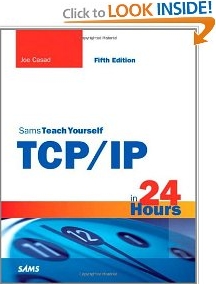TCP/IP Features

In just 24 sessions of one hour or less, you’ll discover how to implement, monitor,
and manage a TCP/IP network–even the latest cloud-based and IPv6 networks. Using this
book’s straightforward, step-by-step approach, you’ll uncover the essentials of TCP⁄IP
and put that knowledge to work through practical examples. Each lesson builds on what
you’ve already learned, giving you a strong real-world foundation for success. Expert
author and network engineer Joe Casad guides you from the basics to advanced
techniques—including TCP/IP’s architecture, layers, subnetting, CIDR, routing, security,
utilities, remote access, web services, streaming, and much more.
Practical discussions provide an inside look at TCP/IP components and protocols.
Step-by-step instructions walk you through many common tasks. Q&As at the end of each
hour help you test your knowledge. Notes and tips point out shortcuts and solutions
and help you steer clear of potential problems.
If you’re looking for a smart, concise introduction to the protocols that power the
Internet, start your clock and look inside. Sams Teach Yourself TCP/IP in 24 Hours is
your guide to the secrets of TCP/IP. Learn how to...
• Understand what TCP/IP is, and how it works
• Discover how IPv6 differs from IPv4, and how to migrate or coexist with IPv6
• Work with TCP/IP’s Network Access, Internet, Transport, and Application layers
• Implement flexible addressing with subnetting and CIDR
• Establish efficient and reliable routing
• Implement name resolution
• Secure TCP/IP networks—detect and prevent attacks
• Automatically configure TCP/IP clients and hosts
• Provide classic TCP/IP services and powerful new Web services
• Use TCP/IP in advanced cloud-based environments
• Support efficient media streaming and webcasting
• Capitalize on the benefits of the new HTML5 standard
• Run TCP/IP protocols over wireless networks
• Troubleshoot TCP/IP networks with ping, traceroute, and other tools
• Provide for monitoring and remote access
• Deploy efficient email systems with POP3, IMAP4, and SMTP
• Walk through all facets of implementing a TCP/IP network
Excerpt:
TCP/IP Features
TCP⁄IP includes many important features that you'll learn about in this book.
In particular, pay close attention to the way the TCP⁄IP protocol suite addresses
the following problems:
O Local addressing
o Routing
o Name resolution
o Application support
These issues are at the heart of TCP⁄IP. The following sections introduce these
important features. You learn more about these features later in this book.
Logical Addressing
A network adapter has a unique physical address. In the case of ethernet, the
physical address (which is sometimes called a Media Access Control [MAC] address)
is typically assigned to the adapter at the factory, although some contemporary
devices now provide a means for changing the physical address. On a LAN, lowlying
hardware-conscious protocols deliver data across the physical network using the
adapter's physical address. There are many network types, and each has a different
way of delivering data. On a basic ethernet network, for example, a computer sends
messages directly onto the transmission medium. The network adapter of each computer
listens to every transmission on the local network to determine whether a message
is addressed to its own physical address.
|

